Licensing Foundry Applications
Foundry applications support two types of license, cloud-based login licensing and local RLM licensing. Login licenses require an internet connection, but local RLM licenses are locked to a single machine or license server and don't require an internet connection.
Login Licensing
Cloud-based login licensing provides quick and easy access to all your licenses regardless of which machine you happen to be using. You can use your login license on any machine with internet access, giving you the freedom to work anywhere.
Note: Local RLM licensing is available alongside login licensing. You are not obliged to switch to the login-based model unless you're using an Indie or Non-Commercial license.
Login Licenses
Login licenses allow you to run Foundry applications on any machine using your Foundry account email and password. There's no need to manually install a license, the application takes care of all your license administration. If you don't have a Foundry account, you can create one by clicking Sign up on this page: https://www.foundry.com/user/register
Once you have a Foundry account, you can request an Individual license for Foundry products:
• from Foundry's Sales Department at sales@foundry.com
• from the product pages on our website, such as https://www.foundry.com/products/nuke
• by launching a Foundry application without a license, selecting Try or Buy a License, and then selecting:
• Try - opens a web browser directly to our website's 30-day trial license screen.
Enter your Foundry account details or create a new account and follow the on-screen instructions to receive a trial license.
• Buy - opens a web browser directly to our website to purchase a license.
After purchasing a license, download your Foundry application from https://www.foundry.com/product-downloads
Note: If you were given an Activation Key, navigate to https://www.foundry.com/licensing/activate-product, enter the key, and follow in the onscreen instructions.
-
Launch your Foundry application as described in the Install Guide for your Foundry application by operating system.
-
Select Login License to continue.
-
If this is the first time you've logged in to a Foundry application on this machine, enter your email address and Foundry account password, and then click Sign in.
-
Select the license you want to install from the list and click Install.
-
Click Done to close the Licensing dialog.
The Licensing dialog displays.
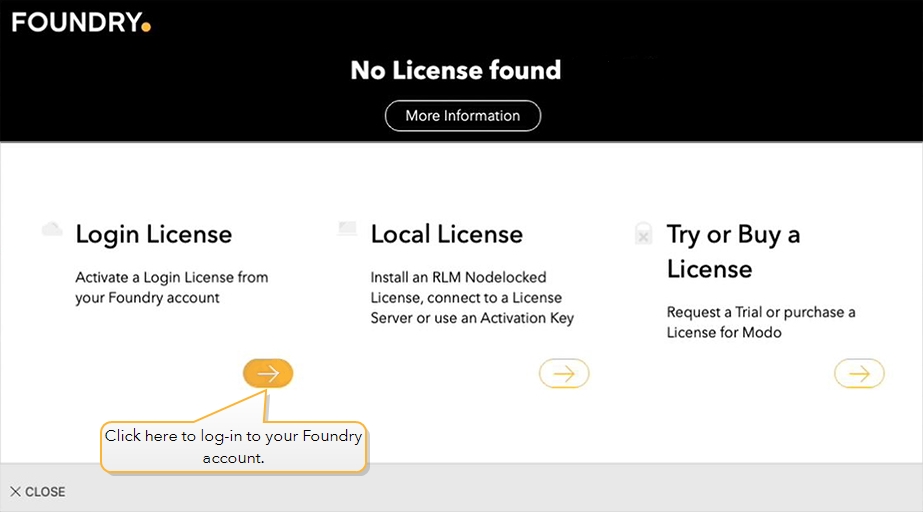
You don't need to enter your Foundry account information again unless you log out of an application.
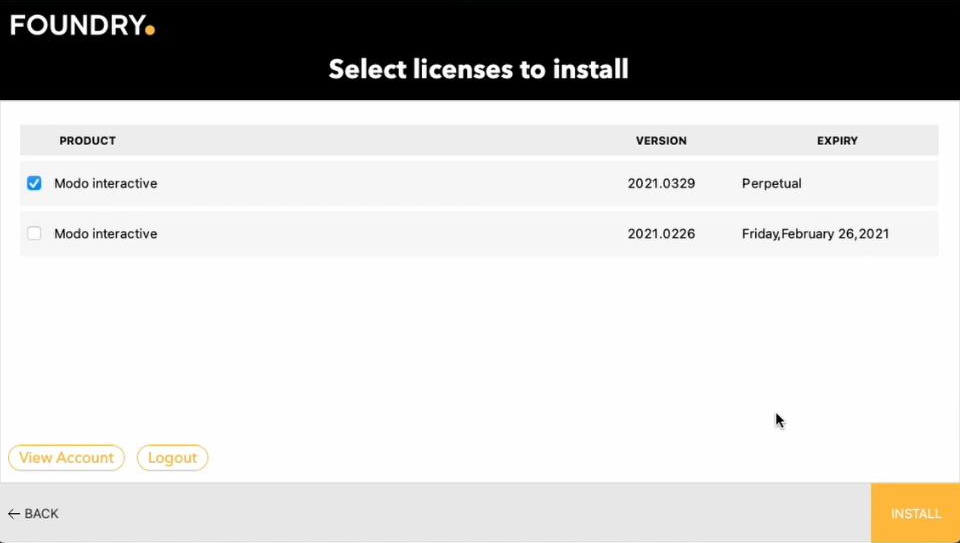
You can now use your Foundry application.
Note: A license is activated for a period of 37 days. Make sure that you connect to the internet at least once during the activation period to extend your access. You can check the activation period of your license in your Foundry application's Help menu.
Deactivating an Individual License
An Individual license is active until you deactivate it or sign out of the Foundry Licensing application. Deactivation means you can activate the license again without needing to enter your email address and password.
Note: Individual licenses can be active on up to two machines concurrently. If you want to activate a license on a third machine, you must return an active license first.
To deactivate a license:
-
Go to your application's Help menu and click Licenses.
-
The License Status dialog displays.
-
Click Manage Login Licenses.
-
Select the license you want to deactivate and then click Return,
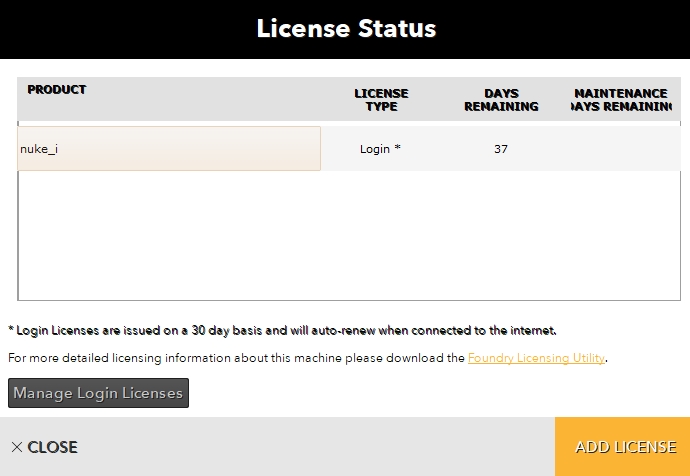
The Return Login Licenses dialog displays.
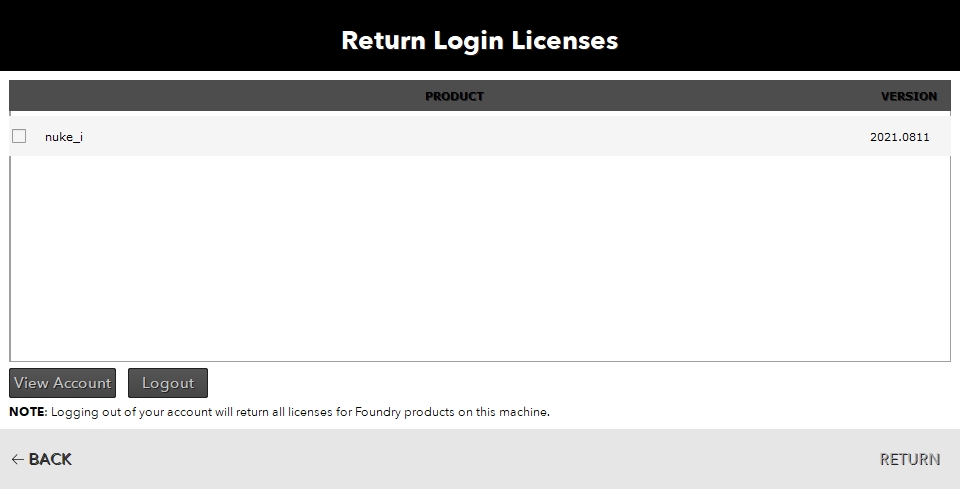
OR
Click Logout to return all of the activated licenses on this machine and clear your login details.
Tip: Returning a license allows you to activate it again without entering your Foundry login details.
Local RLM Licensing
Local licensing using RLM software does not required internet access and so it is well suited to individuals that move around a lot and to site licensing where security considerations mean that there is no access to the internet.
Note: Local RLM licensing is available alongside login licensing. You are under no obligation to switch to the login-based model unless you're using an Indie or Non-Commercial license.
The following local licensing methods are available:
• Activation Keys - activation keys allow you to generate your actual product license key, at a later point after purchase, on the machine for which you require the license.
They are provided for both node locked and floating licenses, and generate the appropriate license type once installed using the application's Licensing dialog. Go to the Activate a Product page to use your Activation Key: https://www.foundry.com/licensing/activate-product
• Node Locked Licenses - these can be used to license an application on a single machine. They do not work on different machines and if you need them to, you’ll have to transfer your license.
Node locked licenses, sometimes called uncounted licenses, do not require additional licensing software to be installed.
• Floating Licenses - also known as counted licenses, enable applications to work on any networked client machine. The floating license is put on the server and is locked to a unique number on that server.
Floating licenses on a server requires additional software to be installed on the server to manage the licenses and give them out to the client stations that want them. This software is supplied as part of the Foundry Licensing Utility can be downloaded at no extra cost from https://www.foundry.com/licensing/tools
Obtaining Local Licenses
To obtain a local license, you'll need your machine's System ID (sometimes called the MAC address, Host ID, or rlmhostid). Just so you know what a System ID looks like, here’s an example:
000ea641d7a1.
Note: For local floating licenses, you'll need the System ID of the license server, not the machines on which you intend to run the application.
There are a number of ways you can find out your machine's System ID:
• Launch the application without a license, click Status, and then scroll down the error report until you see your System ID.
• Download the Foundry License Utility (FLU) from https://www.foundry.com/licensing/tools and run it. Click System ID to display your computer's unique identifier.
When you know your System ID, you can request a local license for Foundry products:
• from Foundry's Sales Department at sales@foundry.com
• from the product pages on our website, such as https://www.foundry.com/products/nuke
• by launching the application without a license and selecting Try or Buy a License and then selecting:
• Try - opens a web browser directly to our website's 30-day trial license screen.
Enter your Foundry account details or create a new account and follow the on-screen instructions to receive a trial license.
• Buy - opens a web browser directly to our website to purchase a license.
Note: By default, if you have installed a temporary license, the application displays a dialog at start-up alerting you to the number of days remaining. If you want to disable this behavior, you can set the FN_DISABLE_LICENSE_DIALOG environment variable to 1 to suppress the warning message about imminent license expiration. See Environment Variables for more information.
To use local license roaming you require a Roaming License. Licenses issued Before July 10th 2020 do not support roaming. New roaming licenses will be issued to customers at Maintenance Renewal time. If you are in Current Maintenance and would like to upgrade your licenses to take advantage of this new feature, please submit a request using this form: https://www.foundry.com/nuke-roaming-license
See Local License Roaming for more information on roaming.
Installing Local Licenses
We recommend using the Foundry Licensing Utility to install local licenses, available from https://www.foundry.com/licensing/tools free of charge. See https://learn.foundry.com/licensing/Content/install.html for more information on installing licenses.
However, you can also install local licenses after starting a Foundry application.
When you start the application before installing a license, a Licensing dialog displays an error informing you that no license was available. The installation process is dependent on what type of license you requested:
• License file - if you requested a license file, typically foundry.lic, this option allows you to browse to the file location and install it automatically. See To Install a Local License from Disk or Local License Text for more information.
• Activation Key or license text - if you requested an Activation Key or license by email, this option allows you to paste the key or license text into the Licensing dialog, which then installs the license in the correct directory. See To Install an Activation Key for more information.
• A floating license - also known as a server license. if you requested a server license to supply licenses to multiple client machines, this option allows you to enter the server address that supplies the client licenses.
Note: You must install a floating license and additional software on the license server to use this option.
See To Use a Floating Server License for more information.
To Install a Local License from Disk or Local License Text
- Save the license file to a known location on disk.
- Launch your Foundry application.
- Click Local License to display the available license installation options and then click License File.
- Click Open File, browse to the location of the license file, and then click Open to install the license automatically in the correct directory,
The Licensing dialog displays.
OR
Copy the license text, paste it over the Drag & Drop or paste license texta License here string, and then click Install License.
License text typically looks something like this:
LICENSE foundry nuke_i 2015.0929 29-sep-2015 uncounted hostid=000a957bfde5 share=h min_timeout=30 start=29-sep-2015 issued=29-sep-2015 disable=VM _ck=da32d7372f sig="60P0450MJRP97E3DP B42C99Y5UAPRMEMGNQ39PG22H4WGH3WFK2KPTXFWJTYR0GYASJBXC0PU8"
The license is automatically installed on your machine in the correct directory.
To Install an Activation Key
- Launch your Foundry application.
- Click Local License to display the available license installation options.
- Click Activation Key and then enter the Activation Key string into the key field.
- Click Activate Key.
The Licensing dialog displays.
A license key typically looks something like this:
nuke-0101-77d3-99bd-a977-93e9-8035
The license is automatically installed on your machine in the correct directory.
Note: Activation Keys require an internet connection. If you access the internet through a proxy server and cannot connect to the activation server, you may get an error dialog prompting you to either:
Click Use Proxy to enter the proxy server name, port number, username, and password. This enables the application to connect to the activation server and obtain a license. The license is then installed automatically, or
Click on the web link in the dialog and use the System ID (also known as hostid) provided to manually activate and install a license.
To Use a Floating Server License
If you requested a server license from Foundry, you receive your license key (foundry.lic) in an email or download. You should also receive a link to the Foundry License Utility (FLU) application to help you install the license key on the license server machine. The server manages licenses for the client machines on your network.
To install a connection to your local license server:
- Launch your Foundry application.
- Click Local License to display the available license installation options.
- Click Server and then enter the port and server name or IP address of the license server.
- Click Connect.
-
Note: You must perform these steps on each client machine that requires a license from the server. The client machines do not need the server tools installed.
The Licensing dialog displays.
The format for the server name is: <port>@<servername>, for example, 30001@red.
Local License Roaming
License roaming allows you to temporarily check out a server license so you can work offline. Licenses are checked out and returned through the Help > License menu or by setting environment variables.
Note: License Roaming is not currently supported by Katana and Mari or with Production Collective and EDU Collective licenses.
There are a few important things to take into consideration with license roaming:
• Roaming is only available to Maintenance customers and requires a new license from Foundry.
• Roaming and returning licenses requires a connection to the license server.
• Roamed licenses are valid for a maximum of 30 days.
• Roamed licenses are only valid on the machine that took the license from the server.
• The number of roaming licenses available on the server decreases by one until you return the license.
Installing the Local Roaming License
To activate roaming licenses you need to request a new roaming license and install the license on your license server.
See Licensing Foundry Applications and To Use a Floating Server License for more details on requesting and installing a server license.
How to Roam a Local License
- Launch the application you want to roam, making sure it has a connection to your license server.
- Go to Help > License.
- Click Manage Roaming.
- Enter the number of days you want the roamed license to last, from 1 to 30 days.
- Click Roam Licenses.
- Click Close.
The Licensing dialog displays.
The Roam Licenses panel displays.
Note: The maximum number of roam days may be less than 30 depending on your license.
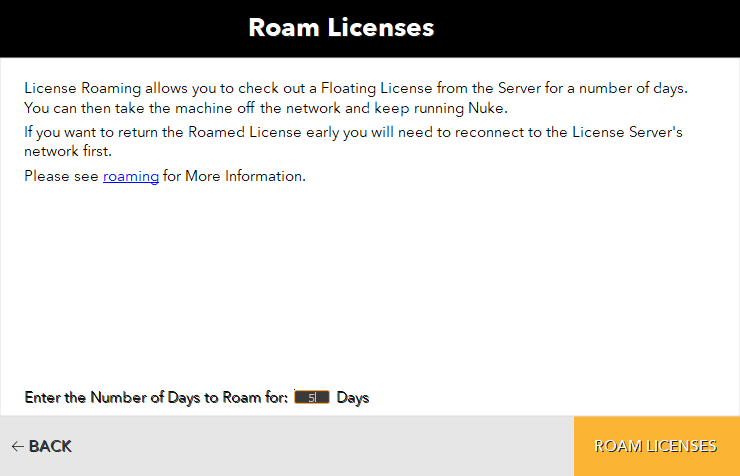
The panel displays the number of roaming days remaining.
How to Return a Roamed Local License
- Launch the application using the roamed license, making sure it has a connection to your license server.
- Go to Help > License.
- Click Manage Roaming.
- Click Return Roam.
- Exit the application to return the roaming license to the server.
The Licensing dialog displays the license type and number of roam days remaining.
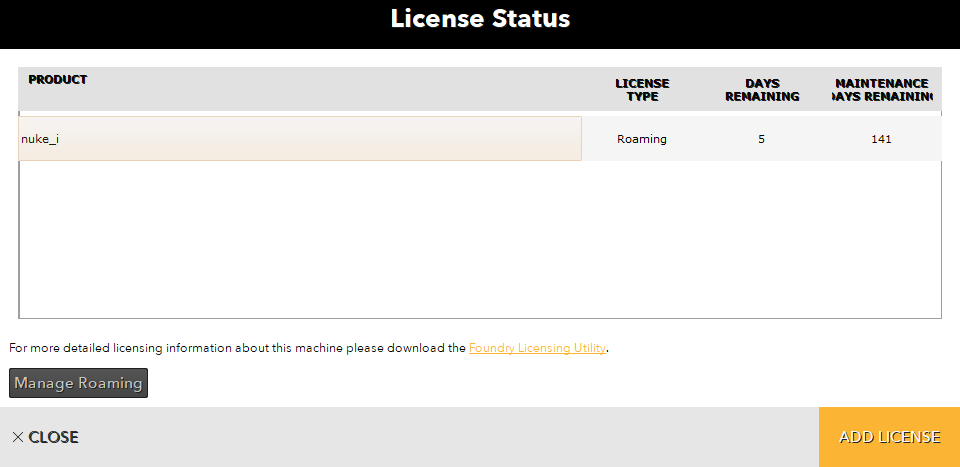
Roaming Using Environment Variables
You can automate some of the aspects of roaming licensing using the RLM_ROAM environment variable supplied by Reprise Software, the third-party vendor of our licensing administration software.
For more information see How to use Roaming Licenses in the RLM Administration Guide:
https://www.reprisesoftware.com/RLM_License_Administration.pdf
Further Reading on Licensing
There is a lot to learn about licenses, much of which is beyond the scope of this manual. For more information on cloud-based login licensing and local RLM licensing, go to our Licensing website: https://learn.foundry.com/licensing/
